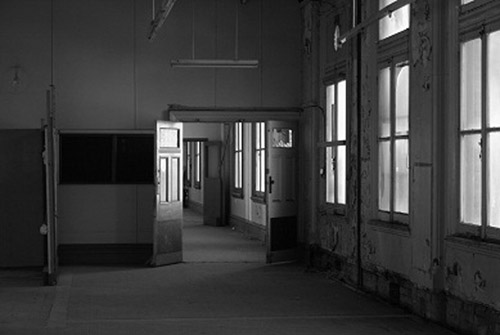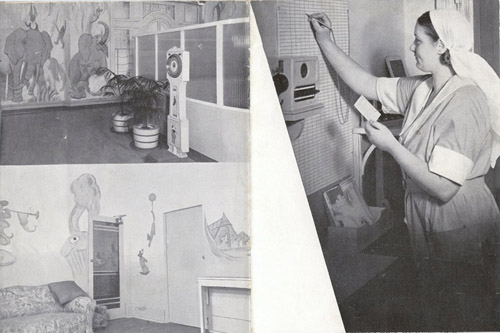SECOND FLOOR: STORIES
inside flinders street station: The MAILROOM
Click here to watch The Age Flinders Street Series: The Mailroom (Source: The Age)
Adoptions from the Station
2nd-Floor---The-large-room-under-the-Ballroom-which-originally-had-partitioned-walls-when-built
|
My aunt who is now 97 was born in 1915. Her mother had died in childbirth and due to a family connection, a married couple from Western Australia lovingly volunteered to rear the child. At the end of five years (1920) they brought my aunt back to Melbourne. At their request, they brought her into Miss Murray in the Children’s Welfare Department located on the 2nd floor of the Flinders Street railway building station where she was legally registered and thereby adopted by the couple. Note: The Children’s Welfare Department was established in the station building in 1910 as the Department of Neglected Children and Reformatory Schools: 2nd floor - rooms 57 to 73 The Victorian Department for Neglected Children and Reformatory Schools had its offices on the second floor, at the western end of the building, from 1911. The Department for Neglected Children and Reformatory Schools was formed in 1887 out of recognition that the previous Department for Industrial and Reformatory Schools could not effectively administer both the needs of neglected children and young offenders. In 1924 the Department for Neglected Children became the Children’s Welfare Department. The Children’s Welfare Department continued to occupy the same offices on the second floor until the late 1950s.
|
Nurse Cleverdon
The-Nursery-Brochure----with-Nurse-Clevedon
|
I was born in 1916 and grew up in Geelong. At age 16 I decided to do mothercraft nursing. This was a one year course and I did my training at the Berry Street Babies Home. The matron there was actually the head of nurses in Victoria and she asked me whether I would like a position at the railways. I started in 1936 -the nursery had been open for only a few years. There were no other nurseries in the city that I know of at the time. I remember my time there well. In the section I worked we only took kiddies that could walk. The oldest was probably about 8 or 9 years of age. We had about 5 permanents, the rest were usually there for only a few hours or so. Often mothers from country Victoria would leave their children to attend Hospital or Doctors appointments etc. We were particularly busy when there were special events or parades in town. Sometimes we were able to go up to the roof and watch the goings on. The Matron, Sister Northcott, was on very good terms with (Commissioner) Clapp. He visited quite regularly and was very proud of the nursery. He once said “it was the only section of the railways that made money”. I don't know anyone's first name. We were all called by our surnames: Northcott, Alan, Boundy, Francis, Brown, Dickerson, Unthank, “Robby” (Robertson), and myself - Cleverdon. I think I’m the only one still alive. There were more than 5 mother craft nurses anyway. J can recognize them from the photos. When the nursery closed for a short time during the paralysis epidemic of 1937, I went and worked in Brighton looking after (Sir) Rupert Clarke's daughter. (The Victorian polio epidemic peaked in 1937/38 and was the worst epidemic experienced in Australia.) I married in 1939 and didn't go back to work there. Instead I've spent nearly 60 years in volunteer service with several hospitals in Melbourne. |
Feeding me at the NurserY
The First Nursery Brochure with a mothercraft nurse feeding Bob
|
I walked into the exhibition at the VRI office in Flinders Street just after Jenny's book was launched in 2009 and couldn't believe there was a photo of me being fed in a high chair in the Children's Nursery! I knew it was me because I have the same photo at home. The year was probably 1936 and I was about 2 years old. The photo was included in a brochure about the nursery. Mum used to go shopping with my grandmother in the city and leave me at the Nursery. Grandpa (Robert Hedley) was a boiler maker at Newport Workshops and his brother Thomas Monteith Hedley was a carriage and wagon builder. Grandpa lived in Footscray and his brother in Williamstown. |
VRI Accountancy Classes (Rm 52)
|
By the age of 17, my dad, Donald K Fidge, was working for the SEC but studying Accountancy at night at the Victorian Railways Institute. Accountancy classes were conducted by George Yeates (during the late 40s), a chartered accountant who had offices in Collins Street. If he was unavailable, his son took the classes. Classes were held from 6pm to 8pm on weeknights at what my dad called “the last room before the locked door” (probably Rm 52 on the 2nd floor – Davies). Dad would finish work at 5pm then go to the lounge and wait for classes to start – he was the only person at these classes who didn’t actually work for the railways. George Yates recommended that dad apply to join the Federal Institute of Accountants and not the Commonwealth Institute which he considered appropriate for his other students. I don’t really understand why but it really didn’t matter as both groups eventually amalgamated. In 2011 dad received a certificate commemorating 60 years membership of “CPA Australia and its antecedent bodies” – only 2 of these certificates were issued in Queensland that year. Dad told me the following about the accountancy classes:
|




